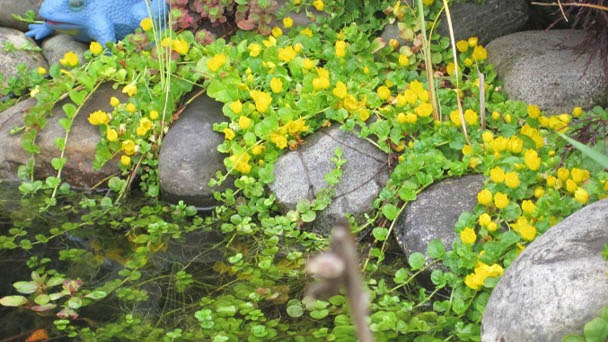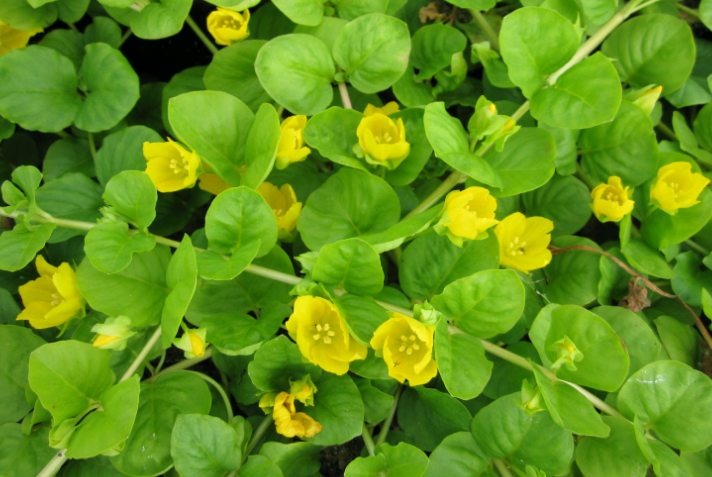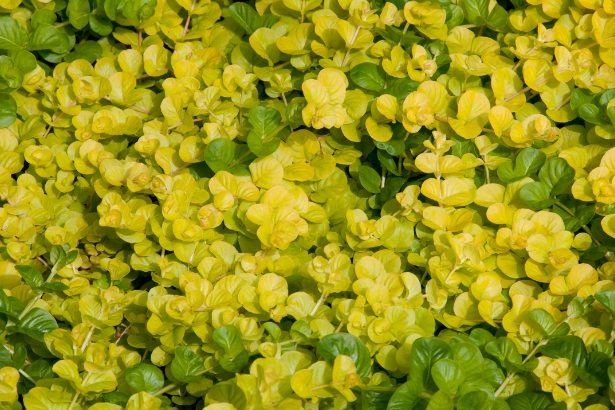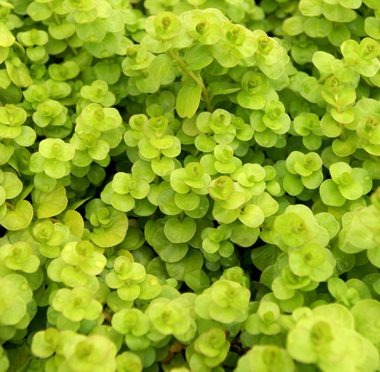Creeping Jenny Plants Careing & Propagation
Written by Ivy
Jan 03 2023

If you're thinking about including an oxygenating pond plant in your water garden, Creeping Jenny (Lysimachia nummularia) ought to be on your list.
With this addition, we will provide you with more details about planting Creeping Jenny. Therefore, stay put as we demonstrate the process of planting in this article. So let's get started without wasting any time.
How to Propagate Creeping Jenny
The creeping jenny can be started from seed and grown from rhizomes or stem cuttings. It can also be easily multiplied by replanting small, shallowly rooted sections of the plant in new locations. Create a germination setup in a greenhouse or a protected area of your garden to grow creeping jenny from seed. This is best accomplished in the spring or summer. Use sterile, fertile soil in containers that are immersed in a few inches of water to keep the soil moist throughout the germination process. When seedlings are big enough to handle, move them into separate pots or containers so they can be separated from one another. In order to plant stem cuttings into soil, they can easily be rooted in water.
If your creeping jenny carpet is well-established, you can easily remove a few patches while making sure to leave the majority of the roots and shoots in place. When the weather is mild or stable, replant these areas in a few inches of fertile, moist soil. These will eventually spread out and send out more roots and branches. To allow for the full spread of this plant and to avoid crowding, make sure that patches are initially spaced 12 to 18 inches (30 to 45 cm) apart.

Step 1: Germinate the Seeds
The ability to grow creeping Jenny from seed makes it a straightforward plant to propagate. Creating a germination set-up in a greenhouse or a protected section of your yard is essential to producing creeping jenny from seed. Ideally, this ought to be finished in the spring or summer.
Remember to use clean, healthy soil in pots immersed in a few inches of water to ensure that the soil stays moist throughout the germination stage. But be concerned. According to the USDA, the soil should be moist but not saturated with water.
Compared to other types of seeds, creeping jenny seeds require a significant amount more water. A seed will begin to grow embryo cells as soon as it is exposed to the right conditions because water and oxygen are absorbed through the seed coat. If there is not enough oxygen, it is possible that germination will not take place.
Step 2: Transfer Germinated Plant to Another Individual Pot Or Area
When the seedlings are big enough to handle, transplant them into separate pots or containers so that they can be as far apart as possible. When planting, it is preferable to add the plant to each planting container in a loose manner rather than tightly.
Fertilize the planting medium's bottom half before setting the plant in the pot and making sure its roots are evenly distributed throughout the planting medium. It is necessary to apply additional planting material up to 2/3 of the way up the plant so that the stems and roots can extend as far as 1-2 inches below the surface of the planting medium.
Step 3: Give Them Support as Hanging Plant
Moneywort is the common name for the long, creeping plant known as creeping Jenny. The plant is perfect for placing in a hanging basket or container because its stems trail over the edges of any indoor container it is grown in.
You can also grow creeping jenny in a standing pot that is supported by a shelf or other object. Once established, it can be challenging to eradicate, and because it enjoys tying another individual to its branches, it will smother or crowd out plants that get in its way.
Once it has grown a bit, this plant grows especially well indoors in a hanging planter or basket, either by itself or in a grouping with other kinds of plants. As a result, it is advised to use them as fillers between rocks or waterfalls so that they can close any gaps. They can also be used as a trailing plant in hanging baskets, window boxes, or other containers so that they can grow outward.
How to Care for Creeping Jenny
The RHS Award of Garden Merit was given to creeping Jenny for its simplicity in maintenance and care. Its colonies are notable for being deer resistant and being immune to diseases and pest invasions. Simply make sure that the soil receives regular irrigation or is kept moist by a nearby source. To suit your tastes, prune trailing shoots.
It can be fertilized with pond water because this species thrives best in neutral to slightly acidic soil. As long as its roots are intact or have grown in stable soil, it can also withstand minor flooding from a pond. Remember that any leftover pieces or roots from removing overgrown patches of this plant could result in the growth of new plants. To avoid aggressive spreading, limit its growth to pots.
How to Trim Creeping Jenny Pond Plants
Once your creeping jenny plants bloom and begin to produce brown or yellow leaves, you might need to trim or prune them. Excess organic matter in the water will be reduced if they are entirely removed.
After the onset of winter, stems and leaves start to wither. Only trim dead foliage from plants that have been planted directly in bogs to a height of 1-2 inches above the water's surface. Prior to carefully lowering plants into the pond, it is a good idea to trim the dead foliage on any plants in pots or on shelves.
Get your submerged plants out of the water in the winter as soon as the ice starts to thaw, preferably before they develop into tall plants. In zones 6 and warmer, it is not necessary to move plants; doing so will not harm them.
Will Creeping Jenny Kill Other Plants
Creeping Jenny comes in a variety of forms, and some people think it's very intrusive. It is easily removeable and manageable. Among the rocks at the pond's edge, its trailing foliage creates a magical texture as it floats in the water. The low-maintenance beauty thrives in a calm stream or allows it to cascade down a waterfall for an eye-catching display.
Along with being attractive, the plant offers medical benefits. Traditional Chinese medicine recommends lysimachia for the treatment of gallstones and urinary bladder stones. The plant contains several phenolic acids, which are frequently used by herbalists to treat wounds. Some medical professionals also apply it to treat gout symptoms.
As an evergreen groundcover, it does well in areas with little other plant life and shade as well as moist (or even soggy) conditions. It will be more resilient to light trampling if it is contained by stepping stones. It thrives best in wet banks, streams, and swimming pools.
Rooting Creeping Jenny in Water
The Creeping Jenny thrives in marginal water gardens and prefers moist soil or an abundant layer of water. Wet stone, which is gray and cool, contrasts dramatically with Creeping Jenny's bright, cheery leaves, which only reach a height of about two inches. In the summer, the flower garden is adorned with a profusion of tiny, delightful yellow flowers.
As an alternative, best for filling voids around rocks and waterfalls with containers, window boxes, and hanging baskets. In locations where it can cascade over walls or banks, Creeping Jenny thrives.
Collection of Stem Cutting
Collecting creeping jenny stem cuttings is the first step in propagating the plant in water. Gathering creeping jenny stem cuttings is best done in the spring and early summer. For propagation, use creeping jenny stems that are 3 to 5 inches long.
Cutting of Stem Tips
The creeping Jenny stem's tip should be cut off with a sharp knife. Make sure to trim creeping Jenny's leaf nodes and buds below. Before propagating, cut the creeping Jenny's leaves off of the lower half of the stem.
The bottom end will be able to easily submerge in water thanks to this.
Rooting Medium
In order to grow creeping Jenny, choose a rooting medium. The creeping Jenny stem cutting grows best in potting soil. Growing creeping Jenny requires the ideal ratio of sand and perlite.
If you want to grow the plant in water, place the roots in an aquarium that is one to two inches deep.
Ensuring Good Sunlight
Maintain the rooting medium in an area that receives sunlight. The creeping jenny needs both strong and moderate sunrays to grow. If a newly rooted plant doesn't get the necessary amount of sunlight, it will die.
Avoid placing your aquarium or pot-medium in a shaded area because the plant's growth will be hampered by the lack of sunlight. However, avoid placing the newly rooted plant in direct sunlight as well.
Root Development
Within ten days, the creepy jenny plant grows roots and new leaves. By that point, the newly rooted plant is prepared for transplantation. The fully rooted creepy jenny plant can then be placed in full sunlight.

How Long Does It Take for Creeping Jenny to Root in Water?
It takes two weeks for creeping jenny to root in water. With soil, a pot filler, and water, creeping jenny can be quickly rooted. Because creeping Jenny requires little maintenance, it requires little work to grow.
Within ten days of the creeping jenny plant's propagation, new leaves begin to develop. In a plant, the stem begins to take shape during that time as the roots begin to form. However, to grow, creeping jenny also needs indirect sunlight, just like other plants.
Root growth slows down and takes longer when there is insufficient sunlight. A stem of creeping Jenny will therefore begin to develop roots in 10 to 14 days in an ideal environment.
What Are the Other Ways to Propagate Creeping Jenny?
The other ways to propagate creeping jenny are from seeds, root mass. From the creeping jenny's flower, seeds are produced. You can quickly buy the seeds from the neighborhood nursery to start a new creeping jenny plant.
Creeping Jenny can be easily multiplied by sowing the seeds in a good potting soil.
Maintaining a creeping jenny is simple. It can flourish in conditions with moist soil, in a pot, and in water. In any environment, creeping jenny can flourish, even in the most challenging ones. It can therefore grow in both areas of full sun and shade.
The seed trays, however, are a little photosensitive. Because of this, position the seed tray where it will receive some sunlight. However, once the seeds have developed into stems and roots, you can move the plant to a new location with access to direct sunlight.
When Can I Divide Creeping Jenny?
By dividing the root ball, you can also spread the creeping jenny. You can divide the creeping jenny during spring and autumn. During this time, you can divide the entire creeping jenny plant and dig out the entire plant with the root.
A different potting medium is then used to propagate the plant.
The leaf node that is in contact with the soil gives rise to roots in creeping Jenny. Only the root can be used to propagate a creeping jenny in its entirety. You only need to remove the plant's roots and stem, then grow the removed portion in a different container.
You can grow the creeping Jenny plant in your home with ease by using this technique.
How to Winter Creeping Jenny
Native to regions with notable seasonal variations is the creeping jenny. While its leaves and shoots typically wither away when exposed to prolonged cold periods, its roots can withstand winter conditions. Although those in hanging baskets and containers can be moved into a greenhouse or cold frame, creeping jenny will thrive outdoors if planted directly into the ground. This would enable you to preserve the plant's shoots for use in propagation over the winter.
If you plan to leave your plant outdoors, you can either trim your creeping jenny plants before the first frosts or just wait for their shoots to wither away. To stop bacterial and fungal growth, make sure to remove any dead or decomposing plant parts. Shoots will naturally reappear in the upcoming spring and quickly spread to create a carpet.
Is Creeping Jenny Invasive Or Toxic?
Creeping Jenny's ability to spread and creeping nature allow it to grow quickly and outcompete local ground cover plants. It is invasive in some parts of the US, especially in states near the Great Lakes and in Indiana, North Carolina, and Virginia. Several native plants have reportedly been outcompeted by it as it has apparently escaped into many natural areas. Food webs have been harmed, and biodiversity has decreased as a result. Its spread has been halted by using chemical, mechanical, and sporadically controlled fire methods.
The horticultural industry prized some creeping jenny cultivars that are less aggressive in terms of growth and spread. The "Aurea" and "Goldilocks" cultivars would be better choices to cultivate as these may be simpler to control in your garden.
Creeping jenny is often mistaken for other invasive plants, such as creeping charlie (Glechoma hederacea). This particular variety of ground ivy also has a creeping habit and leaves that emerge opposite one another along trailing stems. This plant that resembles creeping jenny, however, is mildly toxic and can give grazing animals (especially cats and horses) digestive issues. Despite its potent spreading abilities, creeping jenny is fortunately harmless on its own.
Is Creeping Jenny Edible? Will Fish & Animals Eat It?
Have a hankering for the occasional cup of tea? The creeping Jenny's leaves and flowers can be used to make a warm herbal tea. There aren't many known culinary applications for this plant's parts other than in tea. However, because they don't contain any toxins, they can be consumed in moderation without any problems.
Numerous small animals, particularly slugs and insect larvae, will occasionally graze on the creeping jenny's foliage. Although fish and other pond animals occasionally nibble on this plant, it is not typically known to be eaten by them. Rapidly growing plants don't need to be protected from your pond's wildlife or guests because they can withstand some grazing.

Where to Buy Creeping Jenny & Seeds? (UK & US)
In all areas of its natural range, creeping jenny is available for purchase at plant nurseries. Numerous online gardening or aquascaping retailers also offer potted varieties. There are numerous pot sizes available, ranging from the pint to the gallon. These can either be planted directly into outdoor pond edges or hanging baskets or pots. It is advisable to check your state's list of prohibited or invasive plants before making a purchase if you live in the US.
FAQs
Is Creeping Jenny Toxic to Fish
Golden creeping jenny is a great cover for fish and their fry, substantially reducing tank stress for your fish by providing more hiding places for species that need cover and personal space
Can You Plant Creeping Jenny in Water?
Creeping Jenny can indeed be planted in water. This pond plant is known to thrive in extremely moist soil or water that is at least two inches deep. Consequently, creeping Jenny is a good marginal plant for a water garden.
How Fast Will Creeping Jenny Spread?
If the circumstances are ideal, you can anticipate a season-long growth spread of up to 18 inches (or more).
Does Creeping Jenny Need Sun Or Shade?
Full sun to partial shade is the ideal growing environment for creeping Jenny.
Do Fish Eat Creeping Jenny?
The foliage of creeping jenny occasionally contains a wide variety of tiny creatures, primarily slugs and bug larvae. Although this plant is occasionally consumed by fish and other pond animals, it is not typically recognized as a food source.
Conclusion
You can plant the Creeping Jenny in the following ways. You must now adhere to all maintenance instructions, suggestions, and guidance. After that, post any comments you have in the section below. We'll do our best to respond to you right away.
Latest Updated
- Benefits of Bugleweed - 7 Science-backed Health Benefits
- Bugleweed Dangers & Side Effects - Is It Poisonous?
- How to Plant Evergreen Trees - What You Should Know
- When to Plant Evergreens - Grow Guide for Evergreen Trees
- 12 Wonderful Evergreen Shrubs for Your Garden
- 12 Popular Evergreen Plants with Pictures for Beginners
- When And How To Prune A Lilac Bush Like a Pro
- How to Grow & Care for Lilac Vine (Hardenbergia Violacea)
- Japanese Lilac Tree (Syringa Reticulata) Care & Propagation Guide
- Shumard Oak Pros and Cons - What to Know
Popular Articles
- Winter maintenance of Antirrhinum Majus
- How to Grow Terminalia Mantaly Tree
- How to Grow and Care for Crossostephium Chinense
- How to grow Antirrhinum Majus in spring
- Peristeria Elata (Dove Orchid) Profile: Info & Care Guide
- Underwatered Snake Plant (Sansevieria Trifasciata) - Signs And How To Fix
- How to Care for Brazilian Jasmine Plant (Mandevilla Sanderi)
- How to Grow & Care for Graptopetalum Purple Delight in Summer
- Rosa Chinensis (China Rose): Plant Growing & Care Tips
- How to Care for Baby Sun Rose (Aptenia Cordifolia)